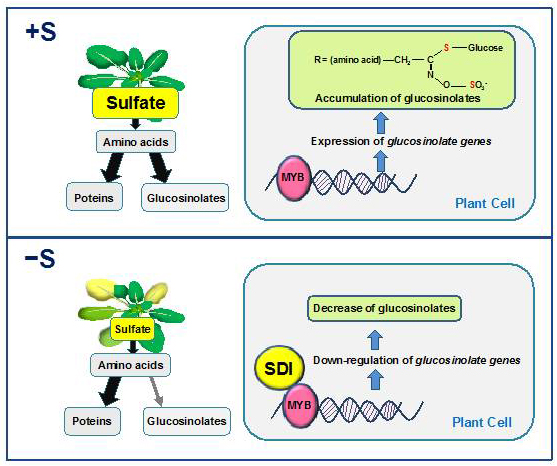Growth or Defence – How Plants set Their Priorities

SDI represses biosynthesis of glucosinolates under sulfur deficient environment (−S) by interacting with MYB28.SDI enables plants to prioritize sulfur usage for primary metabolism under –S MPI-MP
Sulfur is Essential for Plants
Sulfur, like nitrogen, phosphorus, potassium, calcium, and magnesium, is one of the macro-nutrients. Unlike micronutrients, plants need higher amounts of them for development and growth. In case of sulfur deficiency yield losses occur. This is due to the fact that sulfur affects e.g. the synthesis of carbohydrates and is a component of proteins, since the amino acids methionine and cysteine contain sulfur.
However, sulfur does not only play a role in primary metabolism, that is, where energetic substances such as sugars, proteins or fats are formed which are important for growth but sulfur is also a constituent of secondary metabolites that are involved in the synthesis of vitamins and flavours.
A special group of secondary metabolites is found in cruciferous plants such as rapeseed, cabbage, mustard, and horseradish, providing the characteristic bitter taste and pungency. These compounds are referred to as glucosinolates or mustard oil glycosides. Glucosinolates act in plants as protectants against diseases and pest infestation. They are not of much help against humans, though, as we like to eat cabbage, broccoli and co.
Pest Control on the One Hand – Pharmacological Activity on the Other
The pungency and health promoting properties of the cruciferous plants, mentioned above, are due to isothiocyanates derivatives, also known as ‘mustard oils’ produced from glucosinolates when the plant tissues are chewed by humans, pests or insects. Conversion of glucosinolates into mustard oils requires special enzymes that are spatially separated from the glucosinolates in the plant cell. When an insect nibbles on the plant the enzyme and the glucosinolates come together and produce mustard oils. These pungent compounds then repel the insects from the plant and protect it from further infestation.
Produced by the plant for defence, however, these compounds could also have positive medicinal effects. Fayezeh Aarabi, Ph.D. student in the group led by Dr. Hoefgen and the first author of the paper explains: “Mustard oils have antibacterial effects, anticancer properties and, according to the latest research, they could also have antidiabetic effects and activate enzymes of the detoxification metabolism. In order to be able to use the glucosinolates pharmacologically, it is obviously of great interest to understand how their production is regulated in the plant. This is exactly what we have been working on in collaboration with Japanese scientists and now we published our results.”
Regulation of Glucosinolate Production
If a cruciferous plant such as cabbage, rapeseed or the target of investigation in this project, Arabidopsis thaliana, is sufficiently supplied with sulfur, glucosinolates are formed. The production of these metabolites is controlled by so-called transcription factors. Transcription factors are proteins which can bind directly to the DNA. Their task is to ensure that genes are transcribed into RNA and proteins are synthesized, which in turn ensure that the ingredients required by the plant are produced. In the present case the glucosinolates.
Dr. Rainer Hoefgen comments: “With sufficient sulfur supply, the plants can form both the substances necessary for growth and glucosinolates. If the plants receive too little sulfur, the substances essential for growth are formed, while the plant reduces the production of glucosinolates. Growth and reproduction are more important for the plant than accumulation of substances for pest control.”
The identified Sulfur Deficiency Induced genes, so called SDI1 and SDI2 are responsible for reducing the production of glucosinolates. These genes are highly expressed if sulfur deficiency occurs. As a result, the proteins SDI1 and SDI2 are formed which form a complex with a transcription factor of the glucosinolate pathway, namely MYB28. This complex leads to the fact that the transcription factor can no longer perform its function and consequently fewer enzymes of the glucosinolate biosynthesis pathway are synthesized and thus, also less glucosinolates are produced.
“Our new understanding of the regulation of glucosinolate production is an important step to better control the synthesis of medically effective ingredients in plants, either through improved and optimized sulfur fertilization or the development of new breeding strategies,” says Fayezeh Aarabi.
Contact:
Dr. Rainer Höfgen
Max Planck Institute of Molecular Plant Physiology
Tel. +49 331 567 8205
hoefgen@mpimp-golm.mpg.de
Ursula Ross-Stitt
Public Relations
Max Planck Institute of Molecular Plant Physiology
Tel. +49 331 567 8310
Ross-stitt@mpimp-golm.mpg.de
Original publication
Fayezeh Aarabi, Miyuki Kusajima, Takayuki Thoge, Tomokazu Konishi, Tamara Gigolashvili, Makiko Takamune, Yoko Sasazaki, Mutsumi Watanabe, Hideo Nakashita, Alisdair R. Fernie, Kazuki Saito, Hideki Tagalhashi, Hans-Michael Hubberten, Rainer Hoefgen, Akiko Maruyama-Nakashita
Sulfur-defieciency-induced repressor proteins optimize glucosinolate biosynthesis in plants
Science Advances, 2016; 2 (10):e1601087, eCollection; doi: 10.1126/sciadv.1601087
http://www.mpimp-golm.mpg.de/2090184/growth-or-defence (press release)
http://www.mpimp-golm.mpg.de/2168/en (Website of the Institute)
Media Contact
All latest news from the category: Life Sciences and Chemistry
Articles and reports from the Life Sciences and chemistry area deal with applied and basic research into modern biology, chemistry and human medicine.
Valuable information can be found on a range of life sciences fields including bacteriology, biochemistry, bionics, bioinformatics, biophysics, biotechnology, genetics, geobotany, human biology, marine biology, microbiology, molecular biology, cellular biology, zoology, bioinorganic chemistry, microchemistry and environmental chemistry.
Newest articles

A ‘language’ for ML models to predict nanopore properties
A large number of 2D materials like graphene can have nanopores – small holes formed by missing atoms through which foreign substances can pass. The properties of these nanopores dictate many…

Clinically validated, wearable ultrasound patch
… for continuous blood pressure monitoring. A team of researchers at the University of California San Diego has developed a new and improved wearable ultrasound patch for continuous and noninvasive…

A new puzzle piece for string theory research
Dr. Ksenia Fedosova from the Cluster of Excellence Mathematics Münster, along with an international research team, has proven a conjecture in string theory that physicists had proposed regarding certain equations….



